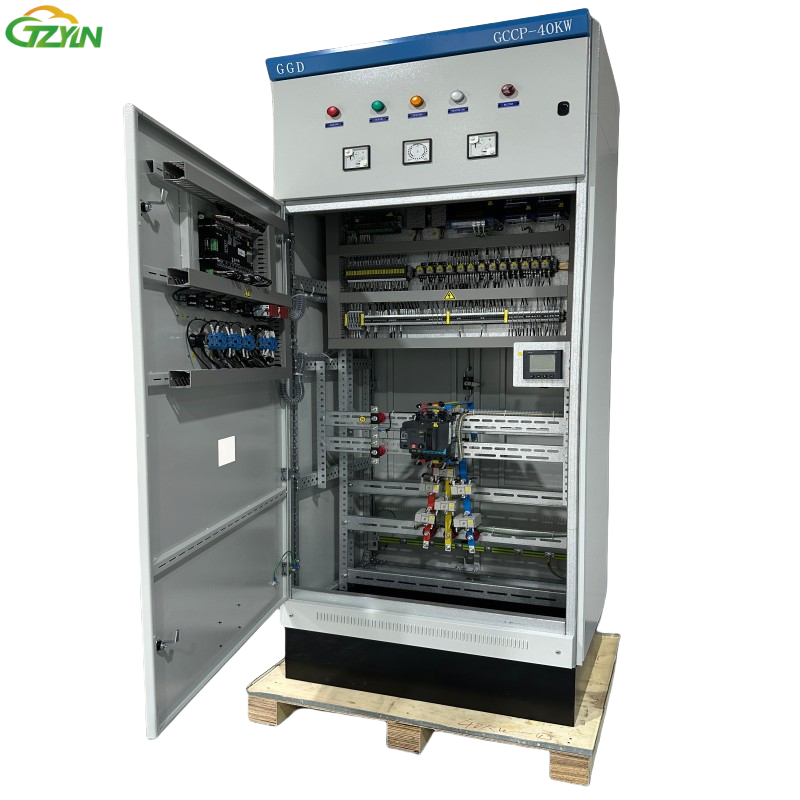The synchronization process in generator control panels ensures that electrical parameters like voltage, frequency, and phase align perfectly. This alignment allows multiple generators to work together seamlessly. Without proper synchronization, you risk equipment damage, power instability, and safety hazards. By mastering this process, you can enhance generator efficiency, maintain system reliability, and ensure safe operations. Whether you manage a single generator or a complex power system, understanding synchronization is essential for optimal performance.
Overview of the Synchronization Process
Definition and Purpose
The synchronization process ensures that multiple generators or a generator and a power grid operate in harmony. It involves aligning key electrical parameters like voltage, frequency, and phase angle. This alignment allows generators to share the load efficiently without causing disruptions. You rely on this process to prevent equipment damage and maintain stable power delivery. By synchronizing correctly, you ensure that all connected systems work as a unified whole.
Scenarios Requiring Synchronization
You encounter the need for synchronization in various situations. When connecting a generator to an existing power grid, synchronization becomes essential. It also applies when you operate multiple generators in parallel to meet higher power demands. In marine environments, synchronization ensures that onboard generators connect seamlessly to a common busbar. Additionally, during maintenance or emergencies, you may need to synchronize backup generators with the main system. Each scenario highlights the importance of precise alignment to avoid operational issues.
Importance of Proper Synchronization
Proper synchronization safeguards your equipment and ensures reliable power supply. Misalignment can lead to severe consequences, including voltage fluctuations, frequency instability, and mechanical stress on generators. These issues not only reduce efficiency but also pose safety risks. By mastering synchronization, you minimize these risks and extend the lifespan of your equipment. Furthermore, proper synchronization enhances energy efficiency, which helps you reduce operational costs. It also ensures uninterrupted power delivery, which is critical for industries and facilities relying on consistent electricity.
Key Components and Tools for Synchronization
Essential Equipment
Governors
Governors play a critical role in controlling the speed of your generator. They adjust the fuel supply to maintain a stable frequency, which is essential for synchronization. Without proper speed control, your generator cannot match the frequency of the power grid or other generators. By ensuring precise speed adjustments, governors help you achieve smooth and efficient synchronization.
Automatic Voltage Regulators (AVRs)
Automatic Voltage Regulators (AVRs) manage the voltage output of your generator. They stabilize voltage levels by adjusting the excitation current in the generator's alternator. This ensures that the voltage matches the required parameters for synchronization. AVRs prevent voltage fluctuations, which can disrupt the synchronization process. With an AVR, you can maintain consistent voltage levels and protect your equipment from potential damage.
Synchronizing Relays and Meters
Synchronizing relays and meters provide you with the tools to monitor and control the synchronization process. Synchronizing relays automate the connection of generators to the power grid or other generators. They ensure that voltage, frequency, and phase angle align before closing the circuit breaker. Synchronizing meters, on the other hand, display real-time data on these parameters. By using these tools, you can make informed decisions and achieve accurate synchronization.
Features of Synchronization Panels
Indicators and Alarms
Synchronization panels include indicators and alarms to keep you informed about the status of your system. Indicators display key parameters such as voltage, frequency, and phase angle. Alarms alert you to any irregularities or faults during the synchronization process. These features help you identify and address issues quickly, ensuring safe and efficient operations. By relying on these visual and auditory cues, you can maintain control over the synchronization process.
Manual vs. Automatic Synchronization Modes
Synchronization panels offer both manual and automatic modes to suit your operational needs. In manual mode, you control the synchronization process step by step. This gives you the flexibility to make adjustments based on specific requirements. Automatic mode, however, uses advanced systems to handle synchronization with minimal input from you. It ensures faster and more precise alignment of electrical parameters. By choosing the appropriate mode, you can optimize the synchronization process for your application.
Step-by-Step Synchronization Process
Preparation and Initial Checks
Inspecting Components
Before starting the synchronization process, inspect all components thoroughly. Check the generator's mechanical and electrical systems for any visible damage or wear. Ensure that the governor, automatic voltage regulator (AVR), and synchronizing relays are functioning correctly. Faulty equipment can disrupt the synchronization process and lead to operational failures. By conducting a detailed inspection, you reduce the risk of errors and ensure a smooth process.
Ensuring Voltage, Frequency, and Phase Sequence Alignment
Verify that the generator's voltage, frequency, and phase sequence align with the system you plan to connect. Use synchronizing meters to measure these parameters accurately. Adjust the generator's settings if you notice any discrepancies. Proper alignment is critical for preventing power instability and equipment damage. This step ensures that the generator operates in harmony with the existing system.
Synchronization Procedure
Adjusting Speed and Voltage
Start by adjusting the generator's speed to match the frequency of the power grid or other generators. Use the governor to fine-tune the speed until the frequencies align. Next, regulate the voltage output using the AVR. Ensure that the generator's voltage matches the required level for synchronization. These adjustments create the foundation for a successful synchronization process.
Aligning Phase Angle and Frequency
Monitor the phase angle using synchronizing meters. Gradually adjust the generator's speed to bring the phase angle into alignment with the system. Ensure that the frequency remains stable during this process. Proper alignment of the phase angle and frequency minimizes the risk of power surges or disruptions. This step is crucial for achieving seamless integration.
Closing the Circuit Breaker
Once the voltage, frequency, and phase angle are perfectly aligned, close the circuit breaker to connect the generator to the system. Perform this action at the precise moment when the phase angles match. Timing is critical to avoid electrical disturbances. After closing the circuit breaker, monitor the system to confirm that the generator is operating correctly within the network.
Post-Synchronization Checks
Verifying Load Sharing
After synchronization, verify that the generator shares the load evenly with other generators or the power grid. Uneven load distribution can cause mechanical stress and reduce efficiency. Use load-sharing equipment to monitor and adjust the load as needed. Proper load sharing ensures optimal performance and extends the lifespan of your equipment.
Monitoring for Irregularities
Continuously monitor the system for any irregularities, such as voltage fluctuations or frequency instability. Use the indicators and alarms on the synchronization panel to detect potential issues. Address any irregularities immediately to prevent damage to the generator or connected systems. Regular monitoring helps maintain a stable and reliable power supply.
Common Challenges and Solutions in the Synchronization Process
Challenges
Frequency and Phase Angle Errors
Frequency and phase angle errors often disrupt the synchronization process. These errors occur when the generator's frequency or phase angle does not align with the system it connects to. Even minor misalignments can lead to power surges, equipment damage, or operational inefficiencies. You may notice these issues during the initial alignment phase or while monitoring the system post-synchronization. Addressing these errors promptly is critical to maintaining system stability and preventing costly downtime.
Voltage Instability
Voltage instability presents another common challenge. This issue arises when the generator's voltage fluctuates or fails to match the required levels for synchronization. Voltage instability can result from faulty Automatic Voltage Regulators (AVRs), worn-out components, or sudden load changes. If left unchecked, it can cause irregular power delivery, damage sensitive equipment, and compromise the safety of your system. Identifying and resolving voltage instability is essential for achieving a smooth and reliable synchronization process.
Solutions
Advanced Synchronizing Equipment
Investing in advanced synchronizing equipment can help you overcome many challenges. Modern synchronizing relays and meters offer precise control and real-time monitoring of key parameters like voltage, frequency, and phase angle. These tools automate critical steps in the synchronization process, reducing the risk of human error. Some advanced systems also include predictive features that alert you to potential issues before they escalate. By upgrading to advanced equipment, you can enhance accuracy, improve efficiency, and ensure seamless synchronization.
Regular Maintenance and Calibration
Regular maintenance and calibration of your synchronization tools and generator components are vital. Routine inspections help you identify wear and tear, faulty parts, or calibration drift that could disrupt the synchronization process. For example, you should test the governor to ensure accurate speed control and verify that the AVR maintains stable voltage levels. Calibration of synchronizing meters ensures precise readings, which are crucial for proper alignment. By prioritizing maintenance, you can prevent unexpected failures and extend the lifespan of your equipment.
Best Practices for Successful Synchronization
Tips for Optimal Performance
Routine Inspections and Testing
Routine inspections and testing play a vital role in ensuring successful synchronization. You should regularly examine all components of your generator system, including governors, Automatic Voltage Regulators (AVRs), and synchronizing relays. Look for signs of wear, damage, or misalignment. Testing the system under controlled conditions helps you identify potential issues before they escalate. Use synchronizing meters to verify that voltage, frequency, and phase angle align correctly. By staying proactive with inspections and testing, you can maintain system reliability and avoid costly downtime.
Personnel Training
Well-trained personnel are essential for achieving optimal synchronization. You should ensure that your team understands the synchronization process and knows how to operate the equipment effectively. Provide hands-on training sessions to familiarize them with tools like synchronizing meters and relays. Teach them how to identify irregularities and respond to alarms during synchronization. Regularly updating their knowledge on the latest technologies and best practices keeps them prepared for any challenges. Skilled personnel contribute to smoother operations and reduce the risk of errors.
Leveraging Technology
Automated Synchronization Systems
Automated synchronization systems simplify the process and improve accuracy. These systems use advanced algorithms to align voltage, frequency, and phase angle with minimal manual intervention. You can rely on them to handle complex synchronization tasks quickly and efficiently. Automated systems also reduce the likelihood of human error, which enhances safety and reliability. Many modern systems include user-friendly interfaces that allow you to monitor and control the process with ease. By adopting automation, you can save time and achieve consistent results.
Integration with Monitoring Tools
Integrating synchronization systems with monitoring tools provides you with real-time insights into your generator's performance. Monitoring tools track key parameters like load distribution, voltage stability, and frequency alignment. They alert you to irregularities, enabling you to address issues promptly. Some tools also offer predictive analytics, helping you anticipate potential problems before they occur. By combining synchronization systems with advanced monitoring, you gain better control over your operations and ensure long-term efficiency.
The synchronization process in generator control panels plays a vital role in maintaining stable and efficient power systems. By using the right tools and following proper procedures, you can ensure seamless alignment of electrical parameters. Regular maintenance and inspections further enhance reliability and safety. Effective synchronization not only protects your equipment but also optimizes energy efficiency. When you prioritize this process, you create a foundation for consistent and dependable power delivery, which is essential for any operation relying on electricity.




